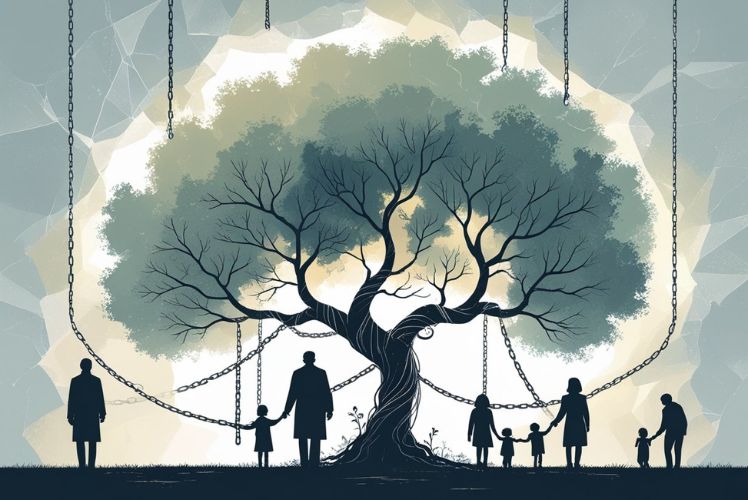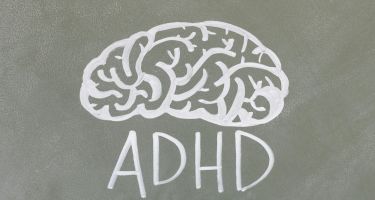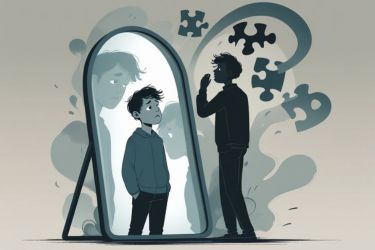Transgenerational trauma is when painful experiences, such as violence, war, or abuse, affect not just the people who lived through them but also their children and grandchildren. This means trauma can silently pass through families, shaping feelings, behaviours, and even health for years to come. Even if someone did not experience the original event, they may still feel its impact in their daily life.

Understanding how trauma travels between generations helps us recognise hidden struggles in ourselves and those around us. As we become aware of these patterns, we can break the cycle and support each other towards healing and resilience.
Key Takeaways
- Transgenerational trauma describes trauma passed down through families.
- It can affect thoughts, feelings, and relationships across generations.
- Awareness and support are key steps to begin healing.
Defining Transgenerational Traumas

Transgenerational trauma refers to the transfer of psychological, emotional, or physiological effects of trauma from one generation to the next. Recognising the differences and features of these traumas helps us better understand their impact on families and communities.
Key Characteristics of Transgenerational Trauma
Transgenerational trauma, also called intergenerational or generational trauma, arises when the effects of a traumatic event are passed down through generations. Attachment patterns, behaviours, and even health problems can reflect this inherited trauma. For example, children of people who have lived through war or violence may show anxiety or mistrust, even if they haven’t experienced the original trauma themselves.
We see this type of trauma not only in families but also in whole communities faced with collective trauma like colonisation or systemic oppression. The way trauma is communicated or kept secret in families shapes how it manifests. If families do not talk about past events, trauma may persist silently, affecting relationships, emotional regulation, and self-esteem.
Transmission occurs through both direct behaviours, such as parenting styles, and more subtle processes like family expectations and beliefs. Insecure attachment, where children’s emotional needs are not met, is one common way trauma may be passed from parents to children. Sometimes, trauma can even show in physical health concerns across generations.
Distinction Between Intergenerational and Historical Trauma
Intergenerational trauma often refers to trauma passed within a family or close community, while historical trauma describes trauma experienced by a large group over time, such as a nation or cultural group. Historical trauma usually stems from events like genocide, enslavement, or colonisation.
Historical and collective traumas can lay the groundwork for intergenerational effects. For example, children of survivors of the Holocaust or the Stolen Generations in Australia have reported ongoing impacts, even decades after the original events. These traumas are maintained through shared memories, community behaviours, and cultural practices.
While both types involve the transfer of trauma’s effects through generations, historical trauma has a wider reach and often involves multiple families or entire communities. Intergenerational trauma is more focused on the family level. However, both can overlap, with collective experiences influencing personal and family dynamics.
A key difference is that historical trauma tends to be linked with external, group-level events, whereas intergenerational trauma is usually more related to direct family relationships and patterns. This distinction helps us choose better support and healing strategies for those affected.
Mechanisms of Trauma Transmission

Transgenerational trauma is carried across generations through several pathways. These include biological factors, patterns within families, and influences shared by groups or communities. Each route plays a distinct role in how trauma is passed from one generation to the next.
Epigenetic Changes and Inheritance
Epigenetics involves changes to gene expression that do not affect the DNA’s underlying sequence. After traumatic events, chemical markers may attach to DNA or related proteins. This can change how certain genes are switched on or off.
Research shows that trauma can lead to epigenetic changes, such as altered stress hormone regulation. These changes sometimes get passed from parents to children. For example, children of trauma survivors may show higher levels of stress or anxiety, even if they have not faced trauma themselves.
Such inherited changes do not guarantee that someone will develop mental health issues, but they can increase vulnerability. The effects can influence emotional responses and health for generations. These findings are helping us understand why some trauma symptoms appear in the children and grandchildren of survivors.
Key Points:
- Epigenetics affects how genes work without changing the genes themselves.
- Trauma can alter gene expression, influencing stress responses.
- These epigenetic changes can sometimes be inherited.
Family Dynamics and Attachment Patterns
Family relationships shape how trauma is shared across generations. The way parents respond to stress and their parenting style can deeply affect children’s emotional development. Children learn behaviours, values, and ways to cope by watching their parents.
In families affected by trauma, parents might have difficulty forming secure attachments. They may feel fearful or anxious, and these emotions can spill over into their children’s upbringing. Sometimes, parents who have not processed their own trauma may unintentionally pass on fears or habits.
Examples of transmission within families:
| Mechanism | Description |
|---|---|
| Parenting style | Overprotective or distant due to past trauma |
| Communication patterns | Silence about the trauma, leading to confusion |
| Emotional climate | Chronic stress or high emotional reactivity |
When unhealthy patterns repeat, children may internalise anxiety or insecurity, even if they do not know the cause.
Cultural and Collective Transmission
Trauma is sometimes shared not just among families, but across entire communities or cultural groups. Events like war, colonisation, or persecution can leave marks on whole societies. We often see shared stories, beliefs, or attitudes that reflect a group’s collective trauma.
These collective messages can shape how future generations see themselves and the world. People may learn to be cautious, distrustful, or proud survivors. Cultural rituals, anniversaries, and shared memories help cement these experiences.
Some communities use storytelling, ceremonies, or education to process collective trauma. Others may reinforce a sense of vulnerability or difference. The way society responds to historical trauma affects how it is remembered, discussed, and managed by new generations.
Manifestations and Impacts Across Generations

Transgenerational trauma can affect families and communities in many ways. We see its influence through mental health, physical symptoms, and patterns of behaviour that trace back to traumatic events experienced by earlier generations.
Psychological and Emotional Effects
Many who grow up in families touched by trauma struggle with mental health problems. We often see increased rates of depression, anxiety, and post-traumatic stress. Children and grandchildren may experience unexplained sadness, emotional numbness, or persistent worries, even if they have not lived through the trauma themselves.
These symptoms can come from the ways our parents and grandparents express their emotions, cope with stress, or talk about the past. Sometimes, silence and secrecy about traumatic events can lead to confusion and a sense of emptiness. Some might feel disconnected from others, leading to social withdrawal and difficulty building trust.
Signs include:
- Ongoing sadness or hopelessness
- Frequent nightmares or flashbacks
- Strong worry or panic for no clear reason
- Low self-esteem and feeling unsafe
Behavioural and Physiological Symptoms
The effects of trauma can also show up in how people act and how their bodies respond to stress. We might notice behavioural problems such as hypervigilance—being always on guard—or hyperactivity in both children and adults. Some families see patterns of anger, aggression, or trouble following rules.
Physiologically, studies report that descendants of trauma survivors can have higher baseline levels of cortisol, the body's main stress hormone. This can make us more sensitive to stress, quick to react in dangerous situations, or always feeling under threat.
Some common signs include:
- Difficulty relaxing or sleeping
- Problems with attention and focus
- Physical symptoms like headaches or stomach pain
- High startle response and tense muscles
Examples from History: Holocaust and Beyond
The Holocaust is a well-known example of trauma passed down through generations. Many children and grandchildren of survivors have faced anxiety disorders, depression, and post-traumatic stress disorder (PTSD), even without direct experience of the original events.
Other groups with similar experiences include Indigenous populations facing systemic oppression and communities affected by war or genocide. In these communities, we see patterns of grief, mistrust, and health problems lasting for decades.
Transgenerational trauma is not unique to any one group. It has been seen after events such as the Rwandan genocide and in First Nation or Native American families. The effects often reflect the original trauma, shaping daily life for future generations.
Diagnosis and Assessment of Transgenerational Trauma

When we diagnose transgenerational trauma, we look for signs that traumatic experiences from previous generations have influenced current mental health. Careful assessment can guide treatment for conditions such as post-traumatic stress disorder (PTSD) and long-term stress.
Identifying Family and Collective Trauma Patterns
We start by examining family history and collective events that may have caused trauma. This can include wars, genocide, displacement, or discrimination. Mapping trauma events across generations helps us understand how stress and difficulties are passed down.
We use tools like genograms to chart family relationships, trauma experiences, and patterns of behaviour. By documenting these details, we can more easily see links between past and present symptoms, such as anxiety, depression, or PTSD.
Key questions we might ask include:
- Are there repeated mental health concerns in the family?
- Have there been major losses or separations?
- Is there a pattern of silence around painful topics?
These patterns help us build a fuller picture of each person’s experience.
Clinical Tools and Psychometric Instruments
We rely on specific instruments to assess transgenerational trauma accurately. Standardised questionnaires measure symptoms of stress, anxiety, depression, and PTSD. Tools such as the Harvard Trauma Questionnaire and the Transgenerational Trauma and Resilience Genogram (TTRG) offer structured ways to identify trauma transmission between generations.
Validated instruments also test internal validity and predictive validity. For instance, a tool that can predict current mental health symptoms based on family history supports our diagnosis. Clinical interviews and attachment assessments further support our findings.
We use a combination of interviews, surveys, and observational data to evaluate trauma’s impact, ensuring a thorough and reliable assessment for each person.
Strategies for Healing and Building Resilience
Healing from transgenerational trauma needs a mix of therapeutic support, building family strengths, and steps to interrupt negative cycles. We can use practical, evidence-based approaches to improve mental health and foster hope.
Family Therapy Approaches
Family therapy gives families a safe space to understand and address inherited wounds. In therapy, members can share their stories, explore patterns, and learn skills for better communication. Trained therapists help us notice unhelpful behaviours passed down through generations.
We can use techniques such as genogram mapping, which charts family relationships and events. This helps us discover links between past traumas and current problems. Cognitive-behavioural methods are also used to challenge harmful thoughts about ourselves or others within the family.
When families create new traditions and open up about the past, trust can begin to rebuild. Some families also include cultural practices or storytelling, which strengthen connections between generations.
Fostering Resilience in Affected Populations
Resilience helps us handle stress and adapt better to life's challenges. We can encourage resilience by developing healthy coping skills like mindfulness, self-compassion, and emotional regulation. Encouraging each other to talk openly about struggles also reduces shame and feelings of isolation.
Support networks matter too. Community groups, cultural activities, and peer support can make a difference. Providing resources for trauma-informed care in schools and community centres gives more people access to help.
Building resilience includes teaching coping strategies to children, so they can manage stress without repeating harmful patterns. Role-modelling positive ways to deal with setbacks shows younger generations that healing is possible.
Breaking the Cycle of Trauma
Breaking the cycle of trauma takes commitment from families, communities, and service providers. We must first notice and acknowledge the sources of pain, then work together to choose healthier responses.
Replacing secrecy with openness is key. Family discussions, supported by trained professionals, help us name and address trauma. Creating new habits—like regular family meetings or shared healing practices—can replace old patterns.
It is important to get professional help when needed. Working with counsellors or joining group therapy programmes can offer guidance and help us maintain progress. Over time, these steps allow us to build a more connected and supportive family environment.
Frequently Asked Questions
Transgenerational trauma shapes how psychological pain and emotional responses are passed down in families. Historical events, scientific theories, and family patterns reveal different ways trauma continues through generations.
What are the primary differences between transgenerational and intergenerational trauma?
We often use the terms interchangeably, but there are subtle differences. Intergenerational trauma usually refers to the transfer of trauma from parents to their children.
Transgenerational trauma is a broader concept and can span several generations, impacting grandchildren and beyond. Both involve the passing of emotional and psychological effects, but transgenerational trauma may cover more distant family lines.
Can you provide examples of transgenerational trauma in historical contexts?
Many groups have faced traumatic events that still affect their descendants. For example, the descendants of Holocaust survivors often report anxiety and grief linked to family history.
Other examples include the ongoing impact of slavery on Black communities, the collective trauma of Indigenous peoples caused by colonisation and forced displacement, and the scars left by wars and famines in affected regions.
How does transgenerational trauma theory explain the transmission of trauma across generations?
According to the theory, trauma does not end with the individual who experienced it. Instead, it affects how people parent, communicate, and cope with stress.
Families may pass down unspoken fears, stress responses, and emotional behaviours. Sometimes, the trauma is not discussed but still influences the atmosphere and relationships in the home.
In what ways can trauma be inherited within family dynamics?
Children can absorb their family's trauma through both direct and indirect means. Parents who experienced trauma may struggle with anxiety, anger, or emotional withdrawal.
Family secrets, silence, or repeated negative patterns can become part of the family culture. Children learn coping strategies and worldviews shaped by these early experiences, even when they have not lived through the original trauma themselves.
What role does epigenetics play in the study of inherited trauma?
Epigenetics looks at how life experiences can affect gene expression without changing the DNA sequence itself. Research suggests that extreme stress or trauma can leave chemical marks on genes that influence how they work.
These marks can sometimes be passed from parent to child, which may help explain why some effects of trauma continue even in later generations who did not directly experience the harm.
Which texts are recommended for in-depth understanding of transgenerational trauma?
For a deeper look into this topic, we can read "It Didn’t Start with You" by Mark Wolynn and "Trauma and Recovery" by Judith Herman. "The Body Keeps the Score" by Bessel van der Kolk is also widely recognised.
Scholarly works such as "Ghosts in the Nursery" by Selma Fraiberg provide important insight. Many academic journals and books in psychology and social work address current research in this area.





















